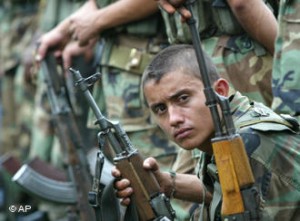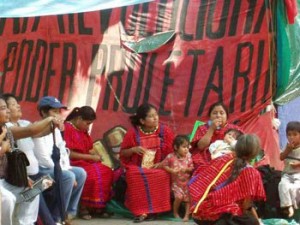By Maria Dolores Paris Pombo
On Apr. 27, a humanitarian caravan carrying journalists, social activists and international observers headed for the Autonomous Municipality of San Juan Copala, Oaxaca, was attacked with high-power weapons by members of the PRI organization UBISORT (the Triqui Region Social Welfare Unit). Alberta Cariño Trujillo, of the organization CACTUS, and Tyri Antero Jaakkolo, a native of Finland, were killed in the attack. For several hours, other passengers in the caravan were missing, compelled to flee into the woods to save their own lives. This humanitarian mission was headed for Copala in order to break the siege that UBISORT, an arm of the Institutional Revolutionary Party (PRI) had imposed. In fact, since the beginning of this year, around 700 inhabitants of the autonomous municipality, surrounded by armed members of UBISORT, have not had access to basic services like water and electricity. The doctor at the health center has had to leave, the children are not attending school, and the scarcity of supplies is worsening daily.
The region of Triqui Baja, located in the Oaxacan Mixteca, has seen a number of years of political conflict between groups fighting to control the communities and access to economic resources from the government. These confrontations have caused hundreds of deaths and the forced displacement of more than half of the Triqui population to other regions of Mexico and to the United States. Since the mid-1990s the conflict has been characterized by assassinations and armed confrontations between MULT (the Triqui Movement for Unification and the Triqui Struggle), and UBISORT. In Jan. 2007, dissidents from both organizations created the Autonomous Municipality of San Juan Copala (MASJC) with the intention of pacifying the region through the creation of an indigenous government which would govern by means of traditions and customs and without the intervention of political parties and organizations.
As is true of many areas of the country, total impunity, the absence of a functioning legal system, and abandonment by state and federal institutions have become dominant features of the region. The lack of justice in response to almost all of the killings and the permanent state of violence has transformed the region into a lawless territory, where human rights are violated daily and where a true climate of terror exists.
But in spite of the notable absence of the federal and state institutions that should be providing basic services, the Triqui Baja region does not lack public resources. On the contrary, in recent years it has received millions of pesos, channeled through MULT and UBISORT. These organizations govern every one of the various neighborhoods of Copala with the connivance and political support of the government of the state, with weapons and with total control of the budget whether it arrives in “their” communities via municipal agencies or goes directly to the leaders. In Sept. 2003, in an interview with Rufino Merino, director of MULT, which took place in the Rastrojo neighborhood, he boasted to me that the governor had just delivered more than 15 million pesos to him for paving the highway from Putla to Juxtlahuaca that crosses the entire region and that today still remains impassable. Furthermore, according to documents of the Secretariat of Social Development, in that year, this same organization received almost 18 million pesos from the program Oportunidades, more than any other organization in the state of Oaxaca, including the official ones.[1]
It is accurate to say that in contrast to other rural regions where this program exists and provides grants to mothers of families, in the Triqui region, the municipal agencies “collect” all the monetary support and make use of it according to their own priorities.
That the state government’s support of paramilitary groups became clear in 2003 when the MULT established the Party of Popular Unity (PUP). The PUP, presented by its directors as the first indigenous political party in the country, is more than anything else yet one more example of the PRI elites’ practices of manipulation and division of the opposition vote and of social movements in Oaxaca. In fact, one of the principle architects of the new state party was ex-governor José Murat. Yet the privileged position that Popular Unity gained as the negotiator for the Triquis with the state government did nothing more than aggravate the violent situation in the region. Some directors of MULTI-PUP marginalized or expelled representatives of the movement who had been recognized as “natural leaders” of their communities. MULTI-PUP also provided arms to paramilitary groups to repress the rise of young leaders.
The isolation of the conflict in Triqui and the withdrawal of social institutions have permitted the imposition of a true dictatorship by MULT-PUP as well as by UBISORT-PRI. In the communities controlled by these armed organizations, all the inhabitants are considered to be “bases” of support and obliged – under threat of fines, beatings or murders – to participate in the mobilizations that include armed confrontations. As well as providing millions in resources, the organizations of the Triqui are powerfully armed and are regularly supplied with munitions and new weapons. Just this February, inhabitants of San Juan Copala who had made a mockery of the UBISORT siege by fleeing to Juxtlahuaco, denounced the leaders of this organization, revealing that it had just received a huge delivery of AK 47s and R 15s and hundreds of bullets which had originated in Santiago Juxtlahuaco.[2]
The declarations of the state and federal governments and the coverage by many of the media when murders and massacres in the indigenous regions come to light always focus on the supposed “ancestral character” of the conflicts and on their so-called nature as “intercommunal fights.” Thus the State appears not to bear any responsibility for what ought to be its most basic function: to guarantee the rights and security of all its citizens. In effect, just as is the case of the so-called “war against drugs,” what happens is that the victims are blamed. It is said that they kill among themselves, something they have allegedly done for centuries, and this attraction to crime and armed confrontation is an integral part of their nature.
The Triqui people have suffered much pain over the years
However, the Triqui people have been truly characterized, more than anything, by their historic tradition of mobilizing in defense of their rights and their identity, of resistance against racist domination and exploitation. As Francisco López Bárcenas demonstrated in a recently published text,[3] the myth of the Triqui–that they are violent by nature—has been fueled using one of the deepest roots of the conflict: racism, which is continuously expressed in the discourse of politicians, administrators, public servants, and especially the media. The regional elites have constructed a discourse of devaluation and rejection of the Triqui which has succeeded in shaping an attitude commonly shared by Mestizos and a good part of the Mexican population.
This racist rhetoric has permitted the trivialization of the endemic violence and has permitted the masking of the connivance of government authorities in the crimes which are committed in the region. At the beginning of February, the murder of ten people in a town in the Triqui Region, San Miguel Copala gained attention. The murder occurred in a dispute between the MULT and the UBISORT over control of the municipal agency. The majority of the victims were inhabitants of the town, among them the municipal agent. However, an engineer who had done work in the zone for the National Water Commission was also killed. At that time, the harassment of the Autonomous Municipality by an armed group led by Rufino Juárez intensified. On the Apr. 20, some media reported the assassination of Celestino Hernández (of the Autonomous Municipality), by a member of the UBISORT whom the community had no trouble identifying.
Today’s victims are defenders of human rights, social activists with broad recognition at a national level and international observers. For the first time in months San Juan Copala, a site of paramilitary activity, is in the international news and occupies the front pages of national newspapers. Even while several people–among them a Belgian and an Italian–are still missing, on Apr. 28, Oaxaca governor Ulises Ruiz, with an impressive lack of feeling, declared to the media that the whole incident had nothing to do with the “foreigners” in the region and expressed his determination to investigate, the foreigners’ immigration status in Mexico through the Office of the Attorney General of Justice of the State.[4]
The governor’s total cynicism is equivalent only to that of Rufino Juárez, director of UBISORT, who after threatening to detain the caravan at all costs now says that the authorities of the Autonomous Municipality are to blame. This cynicism has been fueled by impunity. In fact, armed repression, murder and the criminalization of social protest have been the hallmark of the government of Ulises Ruiz Ortiz. This governor, one of the bloodiest in Mexico, is on the verge of concluding his term without suffering any consequences for his actions. However, the International Civil Commission of Human Rights, in a report, documented 62 murders for political reasons in Oaxaca between June 2006 and April 2008, and the Supreme Court of Justice of the Nation held the government responsible for the violation of human rights committed during the conflict with the Popular Assembly of the Pueblos of Oaxaca (APPO) in 2006. Without pressure from national and international civil society, from international organizations and from the governments of other countries, without doubt, impunity will reign yet again.
Maria Dolores Paris Pombo is a researcher for the Cultural Studies Department at El Colegio de la Frontera Norte.
This article originally appeared in the May 2 edition of El Proceso and was translated by Esther Buddenhagen.
For more information:
Indigenous Community Radio in Mexico
http://americas.irc-online.org/am/5977
Building Civil Society Among Indigenous Migrants
http://americas.irc-online.org/am/1366
Oaxaca: After the Barricades
http://americas.irc-online.org/am/5364
[1] López Bárcenas, Francisco, San Juan Copala, Universidad Autónoma Metropolitana, Unidad Xochimilco, México, 2009
[2] MTI/Texcoco Mass Media/Roger Valle, “Triquis denounce shooting by paramilitary group in Copala”, Mixteca Hoy. Noticias de la Mixteca Oaxaqueña, Feb. 24, 2010
http://www.mixtecahoy.com/mixtecahoy/nota.jsp?nota=1434&seccion=1
[3] López Bárcenas, Francisco, Op. Cit.
[4] Galo Samario, Agustín (correspondent), “Strange participation of foreigners in a zone with problems: Ulises Ruiz”, La Jornada, México, Apr. 29, 2010





